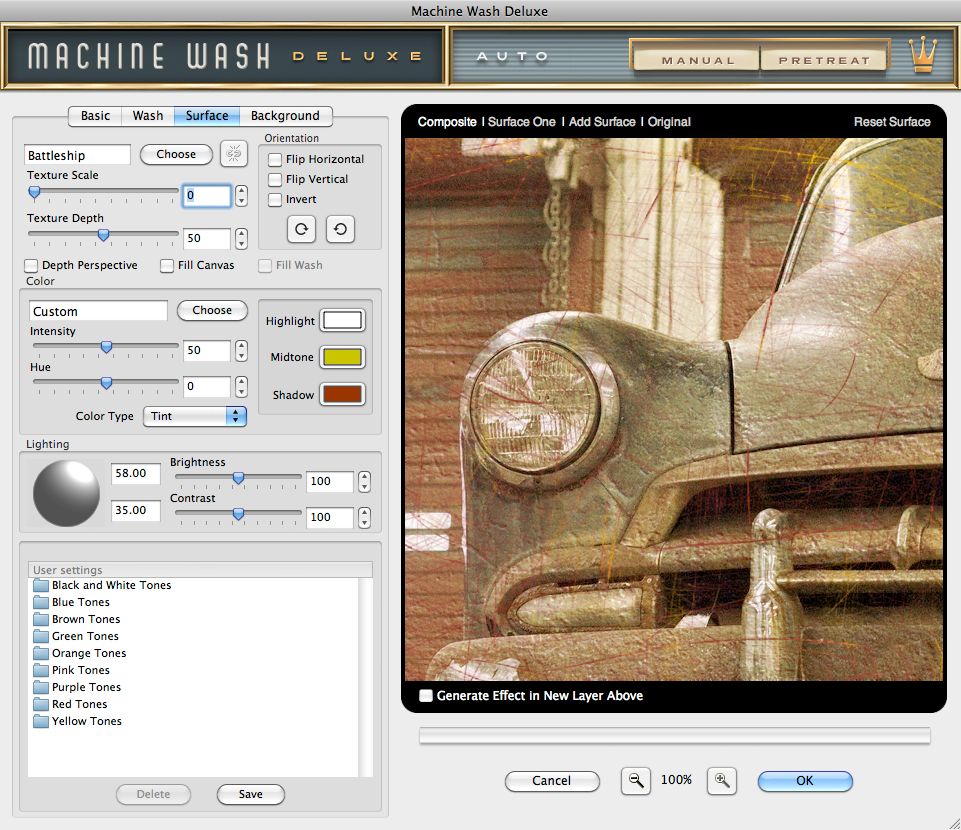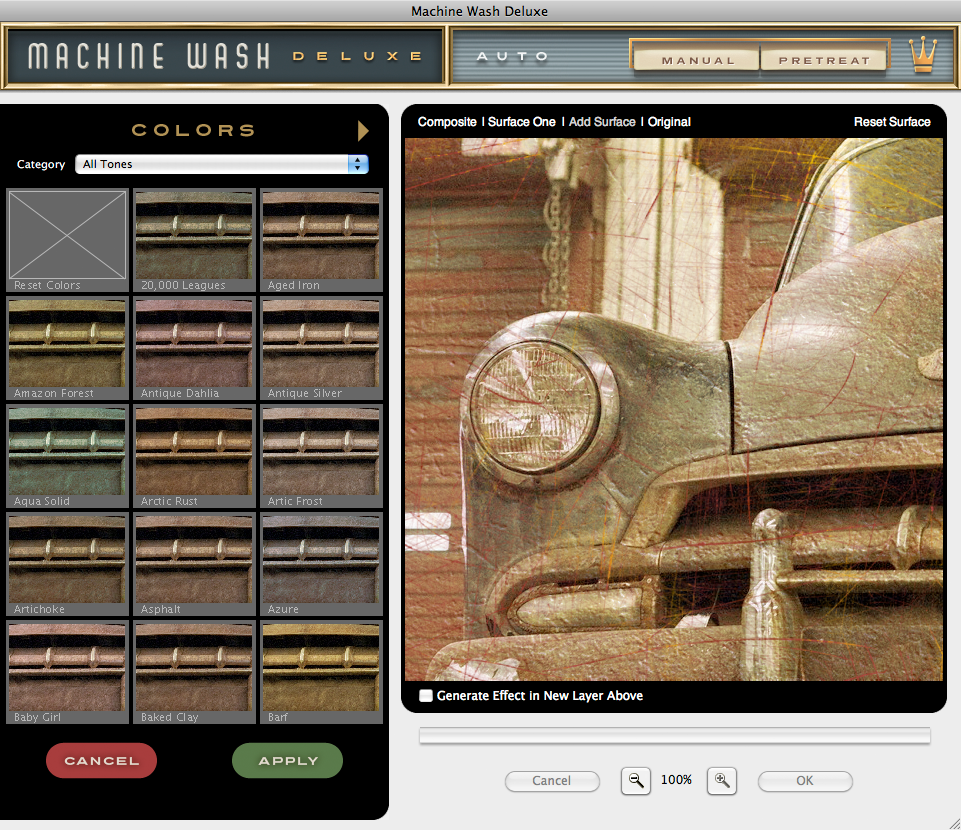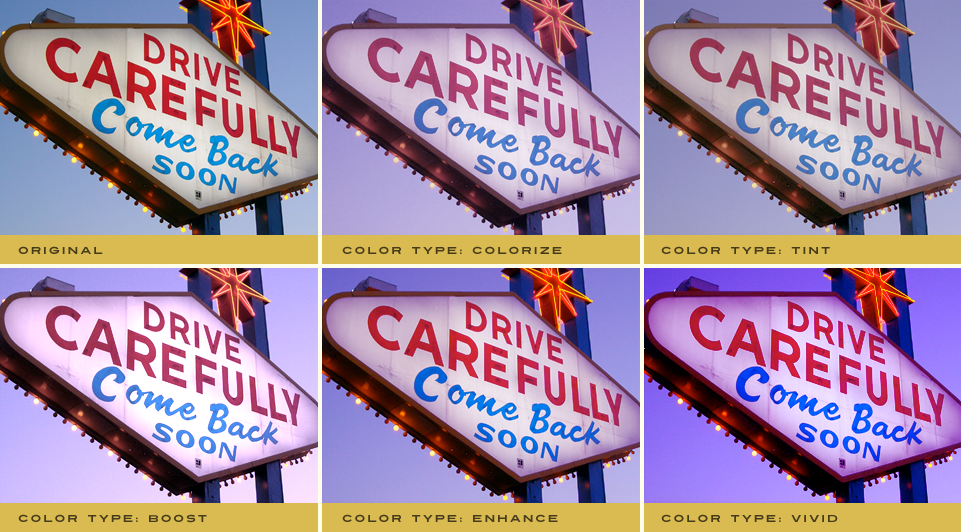Let's Learn About Machine Wash Deluxe
Surface Settings
As if aging and distressing your images wasn't enough, we invented a new way to bring these effects to the next level with Surface. Surface was designed to give your images their very own realistic depth with dimensional textured effects and color in a natural and convincing way and creating this amazing effect couldn't be easier.

|
Select a Surface Texture
- Choose a Surface Texture Effect - To get started, you'll need to choose the texture you'd like to start working with. To do so, simply click the Choose button to launch the Texture Picker. Once you've selected the desired texture you'd like to use, you can proceed to fine-tune using the controls defined below. Additionally, you can select a different texture effect at any time and your current settings will be applied to the new texture.
- Link Texture Effect Option - If you happen to choose a texture effect already in use in another tabbed section of the plug-in, you will be asked by the plug-in if you'd like to link these texture settings. If you wish to link the settings, simply choose which tabbed section settings you'd like to inherit and click Yes to link and apply these settings. If you do not wish to link the settings, simply click the No button.
You may unlink and relink any linked or previously linked textures at any time by clicking the link button to the right of the Choose button. Note you cannot link any multiplier texture effects in the plug-in.
* NOTE - All Surface controls remain disabled until a texture is chosen from the Texture Picker. Additionally, if you're working with multiple Surface effects, you must select either Surface One or Surface Two to edit as all Surface controls will be disabled in the Composite view option.
Adjust the Surface Properties
- Surface Scale - Using the slider control, you may enlarge or reduce the scale of the selected texture effect appropriate to the resolution of the image by moving the slider below or simply enter a number in the text entry field to the right. By default the texture effect is applied at the smallest scale to the image.
- Texture Depth - Increase or decrease the texture depth effect by moving the slider control or by simply enter a number in the text entry field to the right.
- Depth Perspective - When you first apply the Surface effect after you've selected your texture, you'll notice your image now has some great textural depth but this effect does not dimensionally distort your image to match the surface. To create a more natural looking depth perspective effect, click this checkbox to apply the depth effect to the entire image.
- Fill Canvas* - When you load a layered image into the Surface effect, only the layer isolated image is affected by the filter, by enabling this option, you can apply the Surface effect to the entire visible image.
* NOTE - This option is available when you're working with a layered image in Adobe Photoshop or other imaging applications that support layering. - Fill Wash - When the Fill Canvas setting is enabled and you have also applied a Wash effect, this option is available and allows you to fill the Washed areas of the image with the Surface effect as well.
Adjust the Surface Orientation
- Flip Horizontal - Click the checkbox to flip the texture effect horizontally.
- Flip Vertical - Click the checkbox to flip the texture effect vertically.
- Invert Surface - Click the Invert checkbox to inverse the texture effect.
- Rotate - Click either rotate button to rotate the texture effect in 90 degree increments.
Adjust the Surface Color
Any realistic surface is informed by its surroundings, so we've created the ability to colorize the image surface with over 1,500 color presets.
- Surface Color Picker - In the Color dialog box, click the Choose button to launch the Surface Color Picker to select the color tones you'd like to start working with or manually select the Highlight, Midtone and Shadow color tones by clicking the color swatch to the right to launch the application color picker.

|
- Choosing Colors - We've created over 1,500 color tone presets for you to pick from, and to make it easier we've categorized them by color, color type and by color reference. By default, all color tones are presented and can be filtered further by clicking the Category drop down menu along the top and selecting your desired color tone category.
To replace the Surface color tones using the Surface Color Picker, simply click on any thumbnail to quickly update the Surface and preview your selection in real-time. Once you're happy with your selection, click the Apply button to apply the selected color tones and close the Surface Color Picker. If you don't wish to change the color tones, simply click the Cancel button to return to the Surface tab. - Intensity - Increase or decrease the overall color tone strength by moving the slider control or by simply entering a number in the text entry field to the right.
- Hue Adjustment - Click and drag the Hue slider control to adjust the overall color hue of your image.
- Color Type - Machine Wash Deluxe comes with five amazing Surface color types for you to apply to your images:
- Colorize - When selected, this color type colorizes your image using the selected color tones.
- Tint - Tint is selected by default and applies the selected color tones as a tint to your image.
- Boost - When selected, Boost applies the selected color tones to your image for an enhanced pop of color.
- Enhance - When selected, Enhance applies the selected color tone to your image revealing more saturated colors as intensity is increased.
- Vivid - When selected, Vivid applies the selected color tone to your image applying the most extreme saturated colors as intensity is increased.

|
Add Depth to Your Image
- Lighting Control - Click and drag anywhere on the sphere control to change the direction of the source of the light being applied to the image surface or simply enter your desired lighting positions in the text entry fields below the sphere. (TIP: The outer areas of the sphere create a richer color effect, while the inner areas will apply stronger lighting resulting in a lighter image)
- Brightness - Increase or decrease the overall image brightness by moving the slider control or by simply entering a number in the text entry field to the right.
- Contrast - Increase or decrease the overall image contrast by moving the slider control or by simply entering a number in the text entry field to the right.
User Settings - The User Created Settings dialog allows you to save or apply previously saved Surface settings to the image you're working with and we've created over 1,100 great Surface presets to get you started. Once you've created a Surface effect setting you like, click the Save button, name the setting and click OK to save this setting. To recall and apply a setting, simply click on the setting name in the dialog box. To delete a setting, simply click its name in the dialog box and click the Delete button.
Working with the Preview Window
- Preview Options - Above the preview window at right, you'll notice some viewing options. By default the Composite option is selected to show you what all combined tabbed section effects look like applied to the image. At any time you can click the Original option to toggle between the unaffected image and a preview of the filtered image with all effects applied.
- Reset Surface - Reset Surface is located above the preview window on the right. When clicked, it will reset all Surface effect controls to their default state.
- Preview Options - Surface Multiplier - By default you are only working with a single Surface effect (Surface One), by clicking the Add Surface option, you can now define an additional Surface texture effect with its own settings (Surface Two). You can easily toggle between each Surface texture effect by clicking Surface One or Surface Two or click Composite to view the fully composited preview with both Surface effects applied in addition to all combined tabbed section effects. At any time you can delete either Surface effect by clicking the red close box icon to the right of the Surface name.
- Magnifying the Preview - Below the preview window, you'll see the magnification controls. By clicking the appropriate icon (- or +), you can increase or decrease the magnification of the preview window. The current level of magnification is shown between the magnification icons.
Pro Tip - Adobe Photoshop users may use keyboard shortcuts to instantly change the zoom magnification. To fit the full image within the preview window, simply hold down the Command (Apple) key (or the Ctrl key on Windows) then press the number zero (0) on the keyboard. To view the image at 100% size, hold down the Command (Apple) key (or the Ctrl key on Windows) then press the number one (1) on the keyboard. - Moving the Preview - When you have increased magnification and wish to view the texture effect on the rest of the image not visible in the preview window, simply move your mouse into the preview window and click and drag your image around to reveal the texture effected image.
- Re-positioning the Texture Effect - To modify the position of the Surface effect on your image, hold down the Command (Apple) key (or the Ctrl key on Windows) then click and drag within the preview window to reposition the center of the effect.